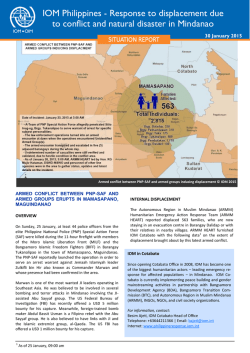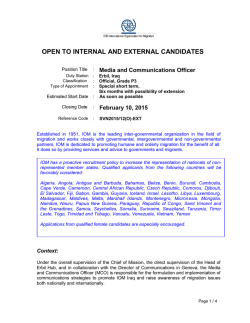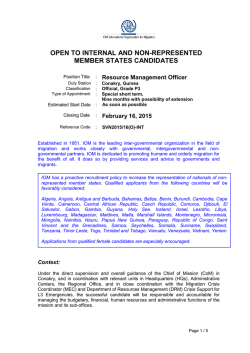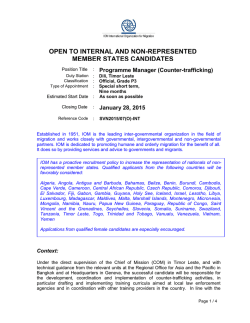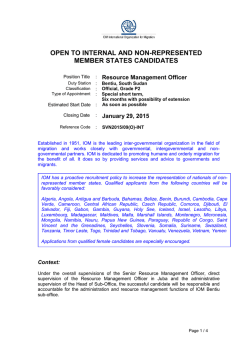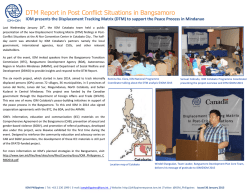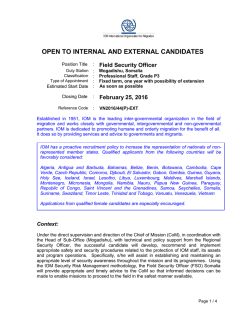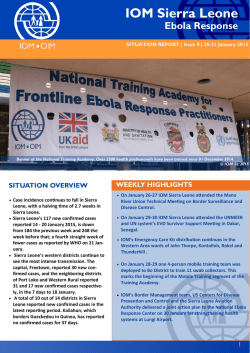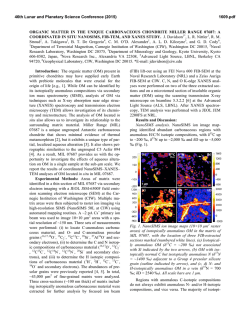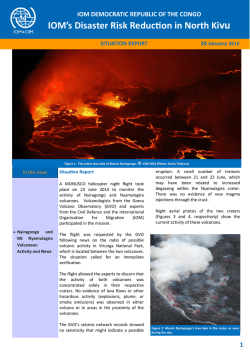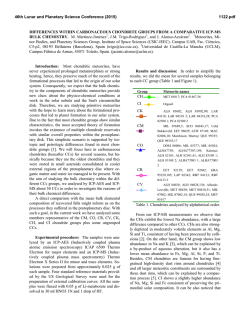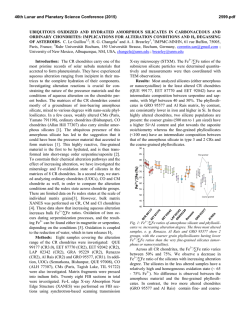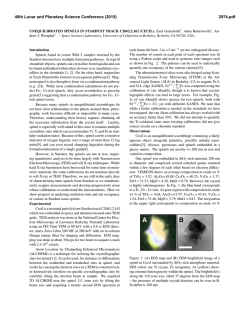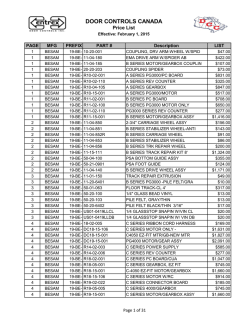
2951
46th Lunar and Planetary Science Conference (2015) 2951.pdf CHEMICAL HETEROGENEITY OF ORGANIC MATER IN MINIMALLY-HEATED CO CHONDRITES. B. T. De Gregorio1, R. M. Stroud2, J. Davidson3, L. R. Nittler3, C. M. O’D. Alexander3, K. Burgess2, A. L. D. Kilcoyne4, 1Nova Research, Inc. (Alexandria, VA; [email protected]), 2Naval Research Laboratory (Code 6366, 4555 Overlook Ave. SW, Washington, DC 20375), 3Department of Terrestrial Magnetism, Carnegie Institution of Washington (5241 Broad Branch Rd. NW, Washington, DC 20015), 4Advanced Light Source, Lawrence Berkeley National Laboratory, Berkeley, CA. Introduction: Previous studies have shown that insoluble organic matter (IOM) from primitive carbonaceous chondrites has a consistent functional chemistry, which can be correlated to petrologic type [e.g., 14]. This bulk functional chemistry was largely established by heating and/or aqueous alteration during parent body processing, while deviations from the bulk functional chemistry within individual particles of IOM derive from unique precursor chemistries (e.g., highly aromatic organic matter) or morphologies (e.g., nanoglobules) that tend to react less to parent body processes, resulting in better preservation of precursor chemistries and/or anomalous isotopic compositions [4]. The CO parent body experienced significant thermal metamorphism, resulting in a range of petrologic types > 3.0 among the CO meteorites. Consequently, IOM from these samples has been studied to understand the effects of heating on meteoritic carbonaceous matter [1, 3, 5]. Poorly graphitized carbon dominates IOM from samples with petrologic type > 3.2 [5, 6], resulting in a loss of information regarding the precursor functionality of this material. Here we investigate the functional chemistry of IOM for a suite of samples of petrologic type < 3.2, where thermally-driven reequilibration of the carbonaceous matter may have been incomplete. Samples and Methods: Five of the least-heated CO chondrites—Dominion Range (DOM) 08006, DOM 03238, DOM 10104, Miller Range (MIL) 05013, and MIL 090010—were crushed and processed to produce high purity IOM residues. Chromium contents in ferroan olivines from each of these samples indicates increasing levels of thermal metamorphism in the order listed [7]. Aliquots of the IOM powders were embedded in S and ultramicrotomed at a 80 nm slice thickness for X-ray absorption near-edge structure spectroscopy (XANES) or at a 30 nm slice thickness for aberration-corrected transmission electron microscopy (TEM). Preliminary mapping to identify nanoglobules in DOM 08006 and MIL 090010 was performed under low dose conditions with a JEOL 2200FS TEM at NRL. XANES was performed using a synchrotron-based scanning-transmission X-ray microscope (STXM) at beamline 5.3.2.2 at the Advanced Light Source. To further investigate sample heterogeneities revealed by XANES, select samples were observed at high spatial resolution with an aberration- corrected Nion UltraSTEM at NRL, using 60 keV electrons at a ~100 pA probe current. Chemical mapping was performed with a Bruker Esprit windowless, solid state detector, energy dispersive X-ray spectroscopy (EDS) system. Using the smallest entrance aperture (1 mm), electron energy-loss spectroscopy (EELS) resolution was measured at 0.35 eV/channel, close to the maximum spectral resolution of 0.1 eV/channel for the XANES data. Under these operating conditions, variations in functional chemistry can be spatially-resolved down to ~1 nm [8], compared with the ~50 nm resolution for XANES. Results and Discussion: The increasing degree of thermal metamorphism (indicated by Cr abundances) across the sample suite is also observed in XANES data of bulk IOM. More heated samples show higher intensity of the aromatic C=C peak at 285 eV, lower intensity of peaks due to ketone and carboxyl functional groups, and development of a distinct *1 peak at 291 eV. These spectral changes indicate that parent body heating aromatizes accreted carbonaceous matter, releasing molecular functional groups, and eventually producing poorly graphitized carbon. Even the least heated IOM (DOM 08006 CO3.00) is more aromatic and contains less N than IOM from CR, CM, and CI chondrites. A similar observation was made for IOM from Allan Hills (ALHA) 77307, another CO3.00 chondrite [2, 4]. Chemical Heterogeneity in IOM. In the two least heated samples (DOM 08006 and DOM 03238), patches of IOM (up to tens of μm2) frequently occur, with spectral features indicative of a lower level of thermal metamorphism (i.e., smaller aromatic C=C peaks, larger ketone and carboxyl peaks, and a less developed *1 peak, relative to the bulk)[Figure 1]. Correlated TEM observations show that this lessheated IOM is also texturally distinct, comprised of coherent, compact carbonaceous matter rather than the typical “fluffy” texture of the bulk IOM. Aberrationcorrected STEM-EELS mapping of additional areas at higher spatial resolution confirmed the presence of these less-heated domains of IOM, with EELS spectra consistent with fewer aromatic C=C functional groups and a higher abundance of ketone and carboxyl functionality. The ~1 nm resolution of the STEM-EELS mapping also revealed several nanodiamonds. 46th Lunar and Planetary Science Conference (2015) Compositional heterogeneity in light elements was also revealed by EDS mapping with the UltraSTEM. Several N-rich particles of IOM, as small as 50 nm, were observed [Figure 2]. These small features would be difficult to resolve with STXM, but their composition and functional chemistry are detectable using the UltraSTEM [8]. 2951.pdf Although μm- and nm-scale isotopic and chemical heterogeneities are common in IOM from primitive chondrites [4, 8, 9], the larger, condensed organic particles in those meteorites do not show the distinct chemical signatures from the “fluffy”, bulk IOM that is seen in the minimally-heated CO samples. This may be due to a differences in functional group chemistry in accreted carbonaceous material as a function of particle size. The CO parent body may be unique in that other carbonaceous chondrite parent bodies accreted more homogenous precursor material. Alternatively, the observation that the less heated functional group chemistry is found preferentially in larger fragments could imply that fine-grained carbonaceous matter dispersed in the matrix or along mineral grain boundaries aromatizes before larger particles or veins of carbonaceous matter during low levels of thermal metamorphism. If the latter hypothesis is true, the presence of chemical heterogeneity in IOM can be used as an additional indicator of petrologic type (3.00 - 3.05) in CO chondrites. Organic Nanoglobules. The functional group chemistry of several nanoglobules was measured in the IOM residues representing the most and least thermally processed chondrites in the sample suite. In both DOM 08006 (N = 9) and MIL 090010 (N = 7), the majority of the nanoglobule spectra are indicative of higher aromaticity than the surrounding IOM [Figure 1]. Only one nanoglobule in DOM 08006 and two in MIL 090010 had XANES spectra that were indistinguishable from bulk IOM. This is consistent with previous work showing a higher abundance of highly aromatic nanoglobules in ALHA 77307 (CO3.00) than in CR, CM, and CI meteorites [4]. References: [1] Busemann H. et al. (2007) M&PS, 42, 13871416. [2] Cody G. D. et al. (2008) EPSL, 272, 446-455. [3] Quirico E. et al. (2009) EPSL, 287, 185-193. [4] De Gregorio B. T. et al. (2013) M&PS, 48, 904-928. [5] Le Guillou C. et al. (2012) M&PS, 47, 345-362. [6] Remusat, L. et al. (2008) M&PS, 43, 1099-1111. [7] Davidson J. et al. (2014) LPSC XLV, Abstract #1384. [8] Vollmer C. et al. (2014) PNAS, 43, 15338-15343. [9] Busemann H. et al. (2006) Science, 312, 727-730. Figure 1. Nanoglobule #9 from DOM 08006. (A) RGB composite image produced from STXM maps of 285.0 eV (aromatic C=C), 286.7 eV (ketone), and 288.5 eV (carboxyl) peak absorption. The central, highly-aromatic nanoglobule stands out from the IOM. Patches of less processed IOM show up in blue (arrows). (B) TEM image of the same area reveals that the less processed IOM (arrows) consists of large particles of condensed carbonaceous matter. (C) XANES data of the nanoglobule and surrounding IOM. Figure 2. Aberration-corrected STEM-EDS from DOM 08006. The high-angle annular dark field (HAADF) image (left) shows texturally “fluffy” IOM, while the EDS map (right) reveals a 150 nm N-rich hotspot. The field of view is approximately 1 μm.
© Copyright 2025

